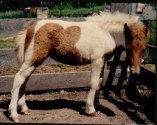Eyes, Tear buildup, causes, treatment...
THE ALL-IMPORTANT EYE
There are few organs as important as the eye. In the horse they are important for the obvious reasons. They provide a way to see in front, to the side, and to the rear. The loss of one eye is even more serious for the horse, as there is little overlap in the viewing area and one eye cannot see objects in the viewing area of the other. With two eyes working perfectly, there is still a blind spot directly in front and directly behind the horse, factors to consider when approaching Dobbin. So with the loss of one eye there is an entire side the horse cannot see. For an animal that uses flight as its primary defense this can be very challenging for both the horse and its handler.
The eye is filled with fluid and divided into two chambers. The back or posterior chamber is the largest, so it has the most fluid and provides the most pressure for keeping the eye full and round. Dividing the two chambers is the lens, the focusing device of the eye. This is the adjustable part of the eye that contracts and relaxes in response to the brightness of the surrounding area. The front or anterior chamber is about one third the size of the back chamber. It forms the clear part we see when we look Dobbin in the eye. The internal pressure of the fluid is what keeps the eye round and full. To keep the pressure from damaging the eye there is a small drain that allows extra fluid to escape. This pools in the lower eyelid and acts as a lubricating substance between the eyelids and the eye. When this reservoir is full, the overflow runs down a tiny tube to empty through a small opening just inside the nostril.
The eye is located within a bony orbit on the side of the skull. This ring of bone provides protection from injury from all but the most severe or direct blows and punctures. If the horse runs into something (yes they really do) there is enough space within the socket to allow the eye some movement. If the eye lids do not close fast enough the surface may be scratched but this is still much better than bursting.
We will discuss a few of the more common conditions, so that you will be aware of the urgency the conditions demand should your horse show up with one of them.
Tearing:
Tearing occurs when the production of tears or fluid from the eye is greater than the tear ductís ability to drain it. The irritated eye will produce extra tears in an attempt to wash away whatever foreign substance there might be. This can be dust, pollen, or a foreign body such as a weed seed. It can just as easily be a scratch on the cornea (the surface of the eye ball). If an eyelid has been torn, the lids may not close tightly, allowing the cornea to be exposed to air or dust. And we must not forget, tearing could be due to a plugged drainage system. If the nasolacrimal (tear) duct is plugged, there is no drainage through the nose, and the tears will overflow from the eyelids. Therefore, tearing is a signal to us the eye is in trouble.
The next step is to determine the cause of the tearing. Sometimes this is obvious. If the cornea is white or has an obvious injury, we have good reason for understanding the tearing reaction. The eye has an amazing ability to heal itself once the problem is corrected. But it can deteriorate just as rapidly if Dobbinís owner procrastinates about seeking treatment. The injured eye is extremely vulnerable to infection. There is little blood supply to the cornea itself, so there are few of the disease fighting cells that patrol the rest of the body picking off bacteria before they can become established. This leaves the eye with little defense against infection. The ragged edges of a wound will be irritated by the eye lids, adding to the intense pain the horse already feels. The horseís only defense is the attempt to hold the lids closed over the eye, and flooding the eye with tears.
By now you are probably in tears yourself. Between now and next week you will gain a greater appreciation for the discomfort Dobbin feels when his eye is hurt!
CLICK BELOW TO DISPLAY A PRINTER-FRIENDLY COPY OF THIS ARTICLE
Select "Open this file from its current location," if you just want to print it out,
it will open in a simple word processing application, select the print button.
(unless you want to save this article in your computer's memory)

 TheAll_ImportantEye.rtf
TheAll_ImportantEye.rtf